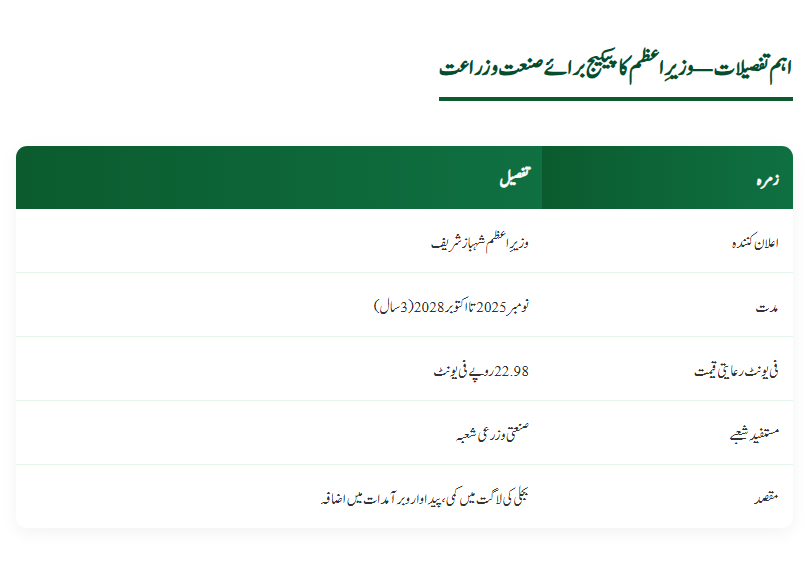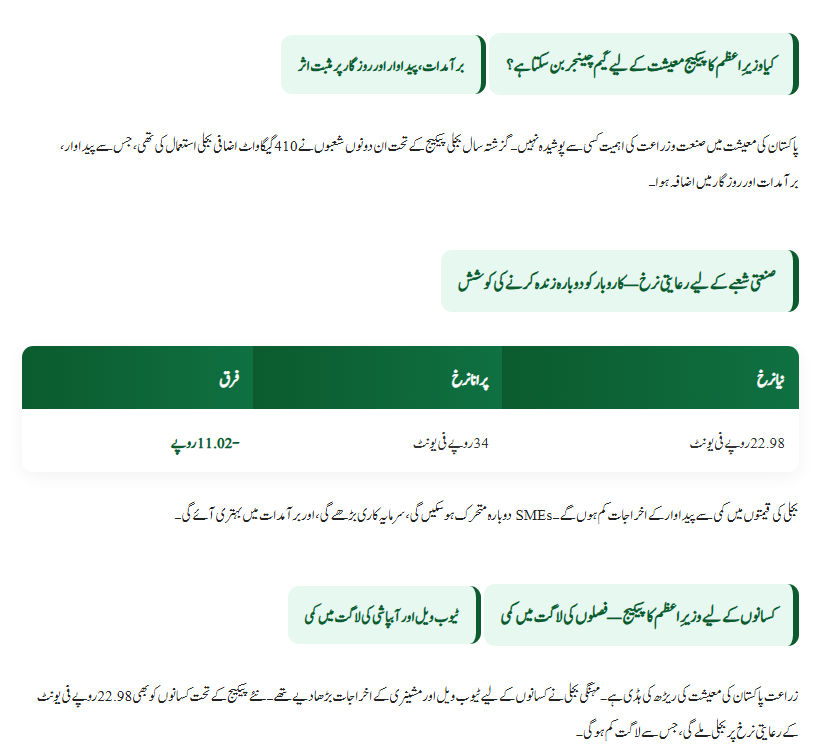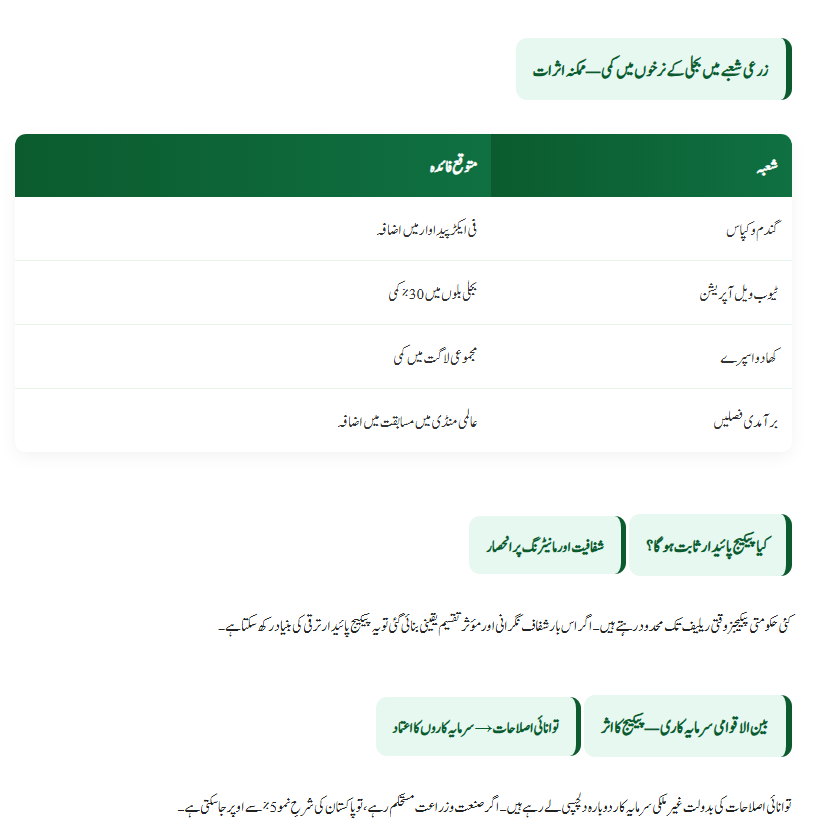For years, Pakistan’s economy has struggled under the weight of rising energy costs, declining exports, and a slowing agricultural sector. Farmers have been facing record-high production expenses, while industries are battling to stay competitive. Amid these challenges, Prime Minister Shehbaz Sharif’s newly announced package for industries and farmers has sparked new hope across the nation.
The government says this three-year relief plan will provide electricity at discounted rates to both the industrial and agricultural sectors, helping reduce production costs, create jobs, and boost exports. Experts are calling it one of the most important economic measures in recent years — but the question remains: Will it truly revive Pakistan’s economy, or is it just another temporary fix?
Key Details — Prime Minister’s Package for Industries and Farmers
| Category | Details |
|---|---|
| Announced by | Prime Minister Shehbaz Sharif |
| Duration | November 2025 – October 2028 (3 years) |
| Discounted Rate | Rs. 22.98 per unit |
| Beneficiaries | Industrial and agricultural sectors |
| Objective | Lower energy costs, increase productivity and exports |

Why Is the Prime Minister’s Package for Industries and Farmers So Important?
The Prime Minister’s package for industries and farmers comes at a crucial time when both sectors are under pressure. Rising energy costs have made it difficult for industries to operate efficiently, and farmers have struggled to manage irrigation and machinery expenses.
Under this new plan, the government will provide additional electricity at Rs. 22.98 per unit throughout the year for the next three years. This means industries and farmers will pay significantly lower rates than before — down from Rs. 34 and Rs. 38 per unit, respectively.
Importantly, Prime Minister Shehbaz Sharif clarified that the cost of this relief will not be passed on to domestic consumers or any other sector, ensuring that this benefit directly supports economic growth without adding burden elsewhere.
Can the Prime Minister’s Package Revive the Economy?
Pakistan’s economic foundation depends heavily on industry and agriculture, the two engines that drive employment, exports, and GDP growth. Last year, under a similar “Roshan Yadak Electricity Package,” industries and farmers used 410 gigawatts of additional electricity, leading to higher production, increased exports, and more jobs.
If this momentum continues, the Prime Minister’s package for industries and farmers could help Pakistan reduce its dependence on loans and move toward self-sufficiency. However, this will depend on how effectively the government implements the program and monitors results.
Discounted Electricity — A Lifeline for Industries
| Sector | Previous Rate | New Rate | Reduction |
|---|---|---|---|
| Industrial | Rs. 34/unit | Rs. 22.98/unit | -Rs. 11.02/unit |
Reducing power tariffs is a major relief for industries, especially small and medium enterprises (SMEs) struggling with high costs. Cheaper electricity means lower production expenses, better profit margins, and increased competitiveness in global markets.
Business associations have welcomed this move, calling it a “lifeline” for the manufacturing sector. Many experts believe this could stimulate industrial investment, export growth, and job creation in the coming years.

What Will the Prime Minister’s Package Mean for Farmers?
Agriculture is the backbone of Pakistan’s economy — yet, over the past decade, high electricity costs have hurt productivity. Farmers rely on electric tube wells and other machinery, making power a critical part of their expenses.
With the Prime Minister’s package for industries and farmers, electricity will be available at Rs. 22.98 per unit, reducing farmers’ power bills by nearly 30%. This will make it easier for them to irrigate fields, operate machinery, and boost crop yields.
If implemented transparently, this package could increase the output of key crops such as wheat, rice, cotton, and sugarcane, leading to higher national food security and better export performance.
How Cheaper Power Can Transform Agriculture
| Area | Expected Benefit |
|---|---|
| Wheat & Cotton | Higher per-acre yield |
| Tube Well Operation | 30% lower energy costs |
| Fertilizer & Spray Costs | Lower overall expenses |
| Export Crops | Greater global competitiveness |

Will the Prime Minister’s Package Deliver Sustainable Results?
Many economic analysts believe that the success of this package depends entirely on implementation. Historically, such relief programs in Pakistan have faced problems like poor monitoring, corruption, and delayed execution.
This time, the government must ensure transparent allocation of subsidized electricity, real-time performance tracking, and strong coordination between energy and finance departments.
If handled properly, the package could mark a genuine shift toward sustainable economic reform — not just a temporary boost.
Can This Package Attract Foreign Investment?
Finance Minister statements suggest that foreign investors are regaining confidence in Pakistan’s economy, especially after recent energy sector reforms.
If the industrial and agricultural sectors stabilize, it could lead to higher foreign direct investment (FDI), supporting economic growth above 5% in the coming years.
Cheaper electricity means Pakistan can offer competitive manufacturing costs — an essential factor for attracting global investors, particularly in textiles, agri-processing, and energy-intensive industries.
Is This Package Linked to IMF Demands?
Some economic experts believe this initiative may align with IMF recommendations to control power losses and electricity theft. By encouraging industries and farmers to consume more electricity through legal, discounted means, the government hopes to increase power sector revenues while reducing theft and inefficiency.
However, government officials insist that this is a homegrown economic reform, not an IMF-driven measure — aimed at empowering producers and revitalizing the economy.
Conclusion — Sustainable Growth or Temporary Relief?
The Prime Minister’s package for industries and farmers represents one of the most ambitious economic relief efforts in recent years. If executed effectively, it could transform Pakistan’s industrial and agricultural landscape by reducing costs, increasing exports, and generating jobs.
But if implementation falters or political interests override economic priorities, this initiative risks becoming another unfulfilled promise.
For now, Pakistan’s business community and farmers are hopeful that this plan will finally bring long-term stability and prosperity — something the country’s economy desperately needs.
Official Source:
🔗 https://www.pmo.gov.pk
Frequently Asked Questions (FAQs)
1. What is the Prime Minister’s package for industries and farmers?
It’s a three-year government plan (2025–2028) offering electricity at Rs. 22.98 per unit to reduce production costs in the industrial and agricultural sectors.
2. When will the new package take effect?
The discounted electricity rates will apply from November 2025 and remain in effect until October 2028.
3. Will domestic electricity consumers be affected by this package?
No. The government has confirmed that the cost of this relief will not be passed on to households or other sectors.
4. How will this package benefit farmers?
Farmers will see lower irrigation and machinery costs, allowing for better crop yields and improved profitability.
5. Could this plan help reduce Pakistan’s foreign debt?
Yes. By increasing industrial output and exports, the plan could boost national revenue and gradually reduce dependency on loans.
Related Posts









